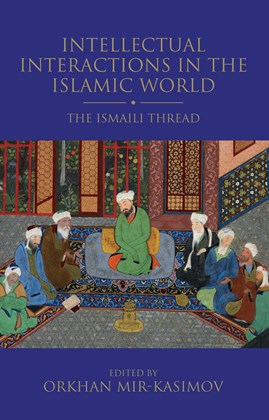Intellectual Interactions in the Islamic World The Ismaili Thread
I.B. Tauris in association with the Institute of Ismaili Studies
How has the Ismaili branch of Shiʿi Islam interacted with other Islamic communities throughout history? The groups and movements that make up Islamic civilisation are diverse and varied, yet, while scholarship has analysed many branches of Islam in isolation, the exchanges and mutual influences between them have not been sufficiently recognised. This book traces the interactions between Ismaili intellectual thought and the philosophies of other Islamic groups to shed light on the complex and interwoven nature of Islamic civilisation.
Based on a broad range of primary sources from the early medieval to the late nineteenth century, the book brings together different disciplines within Islamic studies to cover polemical and doctrinal literature, law, mysticism, rituals and philosophy. The main Ismaili groups, such as the Fatimids, Nizaris and Tayyibis, are represented, as well as lesser known traditions such as those associated with the mountain region of Badakhshan in Central Asia. Religious syncretism, particularly in the Indian subcontinent and in Yemen, is considered alongside cultural interactions as reflected in the circulation of books in Fatimid markets, and various literary and mythical traditions, some still little explored. The chapters include contributions from leading experts in the field that shed new light on the close and complex relationships that very different Islamic groups and movements have enjoyed throughout the centuries.
This volume follows the international conference Intellectual Interactions in the Islamic World: The Ismaili Thread.
Introduction
Orkhan Mir-Kasimov, The Institute of Ismaili Studies, UK
Part I: In the Eyes of Others: Mutual Reflections in Polemical and Doctrinal Literature
1. Sunni Perceptions of the Ismailis: Medieval Perspectives
Farhad Daftary, The Institute of Ismaili Studies, UK
2. Ismaili Polemics Against Opponents in the Early Fatimid Period
Paul E. Walker, The University of Chicago, USA
3. On the Limited Representation of the Ismailis in al-Ṣadūq's (d. 381/991) Kamāl al-dīn
Roy Vilozny, The University of Haifa, Israel
4. 'The Places where the Wrestler is Thrown Down' (Maṣāriʿ al-muṣāriʿ) and the Question of Tūsī's Rejection of his Prior Nizārī Identity
Toby Mayer, The Institute of Ismaili Studies, UK
Part II: Authority and Law
5. Ismaili and Sunni Elaborations of the Sources of Law: The Kitāb al-Majālis wa'l-musāyarāt by al-Qāḍī Abū Ḥanīfa al-Nuʿmān and the Risāla of al-Shāfiʿī: A Comparative Study
Agostino Cilardo, University of Naples "L'Orientale", Italy
6. Sacrifice, Circumcision and the Ruler in the Medieval Islamic West: The Ismaili-Fatimid Legacy
Maribel Fierro, Spanish National Research Council, Spain
7. Human Action, God's Will: Further Thoughts on the Divine Command (amr) in the Teachings of Muḥyī al-Dīn Ibn al-ʿArabī (560–638/1165–1240)
Michael Ebstein, The Hebrew University of Jerusalem, Israel
PART III: The Ikhwān al-Ṣafāʾ, Theosophical and Philosophical Trends
8. Onto-cosmology and Hierohistory in the Manuscript Tradition of the Rasāʾil Ikhwān al-Ṣafāʾ
Carmela Baffioni, The Institute of Ismaili Studies, UK
9. Extra-Ismaili Sources and a Shift of Paradigm in Nizārī Ismailism
Daryoush Mohammad Poor, The Institute of Ismaili Studies, UK
10. Nature According to Ḥamīd al-Dīn al-Kirmānī (d. after 411/1020–21) and Mullā Ṣadrā (d. 1050/1640): Ismaili Influence on a Twelver Thinker or Dependence on Common Sources
Janis Esots, The Institute of Ismaili Studies, UK
Part IV: Mystical Trends
11. Early Ismailis and Other Muslims: Polemics and Borrowing in Kitāb al-Kashf
Mushegh Asatryan, The University of Calgary, Canada
12. The Intellectual Interactions of Yemeni Ṭayyibism with the Early Shiʿi Tradition
Daniel De Smet, KU Leuven, Belgium
13. The Nizārī Ismaili Theory of the Resurrection (Qiyāma) and Post-Mongol Iranian Messianism
Orkhan Mir-Kasimov, The Institute of Ismaili Studies, UK
Part V: Ismaili-Sufi Relationships in Badakhshān
14. Ismaili-Sufi and Ismaili-Twelver Relations in Badakhshan in the Post-Alamūt Period: The Chirāgh-nāma
Nourmamadcho Nourmamadchoev, The Institute of Ismaili Studies, UK
15. The Concept of Wilāya in Mubārak-i Wakhānī's Chihil Dunyā: A Traditional Ismaili-Sufi Perspective on the Origins of Divine Guidance
Abdulmamad Iloliev, The Institute of Ismaili Studies, UK
Part VI: The Interaction and Circulation of Knowledge across Religious and Geographical Boundaries
16. Beyond Space and Time: The Itinerant Life of Books in the Fatimid Market Place
Delia Cortese, Middlesex University London, UK
17. On the Cusp of 'Islamic' and 'Hindu' Worldviews? The Ginān Literature and the Dialectics of Self and Other
Wafi A. Momin, The Institute of Ismaili Studies, UK
18. Spring's Equinox: Nawrūz in Ismaili Thought
Shafique N. Virani, The University of Toronto, Canada
19. Yemeni Ismailism in Jewish Philosophy, 6th/12th to 11th/17th Centuries: A General Historical Sketch
Mauro Zonta, Sapienza University of Rome, Italy
Index
Orkhan Mir-Kasimov is a Senior Research Fellow at the Institute of Ismaili Studies, London. Previously, he lectured at the École Pratique des Hautes Études and the National Institute for Oriental Languages and Civilisations (INALCO) in Paris and worked at various research centres in France and Germany, including the Institute for Advanced Study of Nantes and the Free University of Berlin. He has published works on various aspects of Islamic mysticism and messianism, focusing on the late medieval and early modern periods, including Words of Power: Ḥurūfī Teachings between Shiʿism and Sufism in Medieval Islam (2015), and Christian Apocalyptic Texts in Islamic Messianic Discourse (2017).

